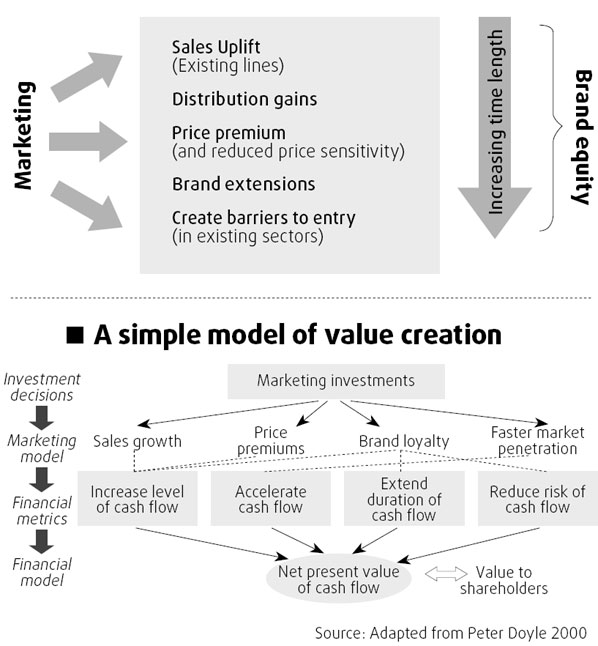

Marketing and Value Creation - is there a link, and can we measure it?
Commercial businesses exist for one purpose: to create and sustain shareholder value. While there are multiple accepted drivers of shareholder value, historically the role of marketing has not been quantified.
So how can marketing professionals quantify the value that they generate? The answer lies in understanding how marketing affects cash flow - specifically the inward flow of cash from sales to end customers of the business. The diagram here lays down a framework for how marketing works in the short and long run.
What is evident from the diagram is that marketing has multiple effects that will vary in size and time to take effect. The standard practice to assess the impact of marketing is to measure the effect on short-term sales (at the top of the diagram). Econometric modeling techniques are employed to accurately determine the effect on incremental sales of all measurable marketing (pricing, advertising, PR, etc) and non-marketing (seasonality, sector growth, competitive activity, etc) drivers. Econometrics is an excellent starting point for marketing accountability analysis since the effect of all significant drivers on incremental sales can be isolated and quantified. Different marketing tactics can be evaluated in terms of their ability to drive sales - and so the optimization of marketing activity in its ability to increase sales is made possible.
However, econometrics on its own is insufficient for a holistic approach to marketing evaluation, and for many CPG products, is likely to prove that marketing, evaluated on short term sales effects only, is not an investment, but a cost - ie has an ROI of less than 1. This is why we need to measure the other effects - and why we require a wider set of analytical techniques. BrandScience uses techniques such as Discrete Choice Modeling to quantify the impact of brand marketing on developing price premiums and Real Options Valuations to measure the optional (or extension) value of brands, on top of robust and holistic Econometric analysis.
The commercial value due to marketing increases as we move down the diagram.
Being able to sustain a price premium, or to avoid costly price promotions, has significantly more impact on profitability than spending money on advertising - it affects the whole brand, rather than incremental sales.
Launching brand extensions offers an opportunity for brand owners to realize new income streams and is especially relevant if they currently operate in saturated sectors with low growth rates.
Increasing barriers to entry through brand loyalty may take a long time to achieve, but once established can be a way to secure inward cash flow and thereby reducing inherent brand risk.
The collective impact of all the effects can be summarized as "Brand Equity". While many definitions of this nebulous concept exist, Tim Ambler of the London Business School usefully defines Brand Equity as the "source of future inward cash flow" and "Understanding how it is created and sustained is essential for short and long term financial health". The late Professor Peter Doyle of Warwick Business School provided some useful insights into how marketing can be linked to the financial reporting of cash flow - they are summarized in the diagram here.
The net present value (NPV) of cash flow represents the value of the commercial enterprise and its future cash flows - this is the current value of the business to its shareholders. The NPV is the combination of two factors
First, a projection of cash flow into the future. We have already seen how marketing can create and sustain (inward) cash flow through manifold effects.
Secondly, the discount rate with which future cash flow projections are discounted to account for risk and the time value of money.
By creating brand loyalty, the risk of future inward cash flow is reduced and a lower discount rate can be applied.
Only by acknowledging and measuring/reporting all of the brand equity effects of marketing can we understand, report and manage the total value that is created by marketing.
The author is director, BrandScience APAC. The views expressed are his own. He can be reached at sam.dias@brandsciencenetwork.com

(China Daily 03/31/2008 page9)













